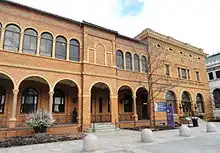James Renwick Jr.
James Renwick Jr. (November 11, 1818, Bloomingdale, in upper Manhattan, New York City – June 23, 1895, New York City) was an American architect in the 19th century. The Encyclopedia of American Architecture calls him "one of the most successful American architects of his time".
James Renwick Jr. | |
|---|---|
 | |
| Born | November 11, 1818 New York City, New York, U.S. |
| Died | June 23, 1895 (aged 76) New York City, New York, U.S. |
| Resting place | Green-Wood Cemetery, Brooklyn |
| Alma mater | Columbia College |
| Occupation | Architect |
| Spouse(s) | Anna Lloyd Aspinwall
(m. 1850; died 1880) |
| Parent(s) | James Renwick Margaret Brevoort Renwick |
| Signature | |
Life and work
Renwick was born into a wealthy and well-educated family. His mother, Margaret Brevoort, was from a wealthy and socially prominent New York family. His father, James Renwick, was an engineer, architect, and professor of natural philosophy at Columbia College, now Columbia University. His two brothers were also engineers. Renwick is buried in Green-Wood Cemetery in Brooklyn, New York, with his wife and father.
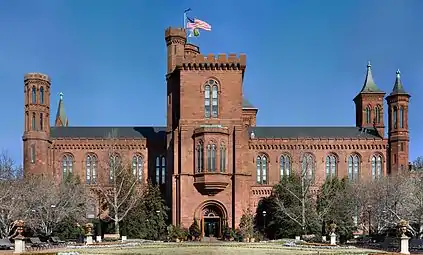
Renwick was not formally trained as an architect. His ability and interest in building design were nurtured through his cultivated background, which granted him early exposure to travel, and through a broad cultural education that included architectural history. He learned the skills from his father. He studied engineering at Columbia, entering at age twelve and graduating in 1836. He received an M.A. three years later. On graduating, he took a position as structural engineer with the Erie Railroad and subsequently served as supervisor on the Croton Reservoir, acting as an assistant engineer on the Croton Aqueduct in New York City.
Renwick received his first major commission, at the age of twenty-five, in 1843 when he won the competition to design Grace Church, an Episcopal church in New York City, which was executed in the English Gothic style. In 1846, Renwick won the competition for the design of the Smithsonian Institution Building in Washington, DC. Built between 1847 and 1855, the many-turreted building, generally referred to as "the Castle," was designed in the Romanesque style, as requested by the Board of Regents of the Smithsonian, and was built of red sandstone quarried at the Seneca Quarry in Seneca, Maryland.[1] It was a major influence in the Gothic revival in the United States.
In 1849, Renwick designed the Free Academy Building (City College of New York), New York City, at Lexington Avenue and 23rd Street. It was one of the first Gothic Revival college buildings on the East Coast.
Renwick went on to design what is considered his finest achievement, and his best-known building, St. Patrick's Cathedral, New York, on the corner of Fifth Avenue and 51st Street. He was chosen as architect for the Roman Catholic cathedral in 1853, construction began in 1858, and the cathedral opened in May 1879. The cathedral is the most ambitious essay in Gothic that the revival of the style produced and is a mixture of German, French, and English Gothic influences.
Another of the prominent buildings Renwick designed was the Corcoran Gallery of Art (now home to the Smithsonian's Renwick Gallery), in the Second Empire style, in Washington D.C. (1859–1871). Other commissions included the first major buildings on the campus of Vassar College in Poughkeepsie, New York (1861–1865), including the Main Hall (1860); Saint Bartholomew's Church (1871–1872) at Madison Avenue and 44th Street in New York City (now demolished); All Saints' Roman Catholic Church (1882–1893) in Harlem in the Victorian Gothic style; and many mansions for the wealthy of the area, including the Peter Aims-Aimes house, "Martinstow", in West Haven, Connecticut. Renwick is revered in Ipswich, Massachusetts, as the architect who designed Ascension Memorial Church, whose cornerstone was laid in October 1869.

Renwick also designed the first chapter house of St. Anthony Hall/Delta Psi, the secret fraternal college society which was founded at Columbia University in 1847. Even though the 1879 structure at 29 East 28th Street is marred now by a street level storefront, in 1990 Christopher Gray wrote in the New York Times that "Old photographs show a high stoop arrangement with the figure of an owl on the peaked roof and a plaque with the Greek letters Delta Psi over the windowless chapter room. In 1879, The New York Tribune called it French Renaissance, but the stumpy pilasters and blocky detailing suggest the Neo-Grec style then near the end of its popularity." In 1899 the fraternity moved to a new chapter house on Riverside Drive and for a few years the original building was kept as a clubhouse for graduate members. At that time a newspaper account described it as a "perfect Bijou of tasteful decoration".[2]
Among his other designs were banks; the Charity and Smallpox Hospitals on Roosevelt Island; the main building of the Children's Hospital on Randall's Island; the Inebriate and Lunatic Asylums on Wards Island and the former facade of the New York Stock Exchange. Renwick was also supervising architect for the Commission of Charities and Correction. A small group of Renwick's architectural drawings and papers are held by the Avery Architectural and Fine Arts Library at Columbia University.
Renwick was also the designer of the bell tower of the Cathedral Basilica of St. Augustine, Florida. The work was commissioned by Standard Oil partner Henry M. Flagler who was building luxury hotels in the historic city at the time. Renwick and his wife Anna Aspinwall lived and owned property in the lighthouse area of St. Augustine on Anastasia Island. In the Spring of 1890, Renwick listened to Franklin W. Smith deliver a speech to garner support for his Design and Prospectus for a National Gallery of History of Art at Washington. Renwick endorsed the idea and offered to provide drawings, plans and illustrations for the project. Smith gratefully accepted and the firm of Renwick, Aspinwall & Russell spent six months completing their contribution.[3]
Firm history
In the late 1850s, already well-established, Renwick temporarily partnered with Richard T. Auchmoty.[4] In the 1860s and 1870s, a few of Renwick's commissions are credited as Renwick & Sands. These indicate Renwick's short-lived partnership with architect Joseph Sands (? – 1879), and include Church of the Holy Sepulchre in NYC, 1869, and the New York City Public Charities Building (razed), at 66 Third Avenue (1868–1871).[5]
One constant in the firm was J. Lawrence Aspinwall (1854–1936),[6] who started to work for Renwick in 1875, practiced in the firm more than 60 years, partner from 1880 to 1925, and became an AIA Fellow in 1914.[7] Aspinwall was the cousin of Renwick's wife Anna.
From 1878 to 1894, the firm was known as Renwick, Aspinwall & Russell, with the partnership of William Hamilton Russell (1856–1907), Renwick's grand nephew. Upon his graduation, Russell became a protégé of his great uncle, who designed the chapter house of Russell's fraternity, St. Anthony Hall, at 25 East 28th Street, New York in 1878, the same year Renwick completed St. Patrick's Cathedral, New York. It is likely Russell contributed work to both his fraternity's first chapter house as well as the cathedral during his apprenticeship with Renwick.[2] Russell departed in 1894 to co-found Clinton & Russell.
After Renwick's death in 1895, the immediate successor organization was called Renwick, Aspinwall & Renwick, then Renwick, Aspinwall & Owen, with the addition of Walter Tallent Owen (1864-1902).[8] In 1904, it became known as Renwick, Aspinwall & Tucker, then Renwick, Aspinwall & Guard by the late 1920s. [9]
Several of Renwick's employees protégés became influential architects in their own right, including:
- Bertram Grosvenor Goodhue, whose designs included the Wolf's Head Secret Society Hall at Yale, the Nebraska State Capitol building, Balboa Park (San Diego), and the chapel at West Point. He began his apprenticeship at Renwick, Aspinwall and Russell in 1884, and his apprenticeship ended in 1891 when he won a national design competition for St. Matthew's in Dallas, Texas. His first years with Renwick's firm partly coincided with Russell's first years, below.
- John Wellborn Root, one of the founders of the Chicago School style.

Major buildings designed
- The Reformed Church of Saugerties, 173 Main St Suagerties, NY (1852)
- Mark Twain House, 21 Fifth Avenue, NYC (c. 1842; razed 1953)[10][11]
- Grace Church, New York (1843–1846)
- Smithsonian Institution Building, Washington, D.C. (1847–1855)
- Calvary Church, New York (1848)
- Free Academy Building, City College of New York, Lexington Avenue and 23rd Street, New York City (1849)
- Oak Hill Cemetery Chapel, Washington, D.C. (1850)
- Rhinelander Gardens, 110-124 West 11th Street, NYC, a three-story above raised basement row of houses (c. 1850; razed 1956)[11]
- Municipal Courthouse, 817 Princess Anne Street, Fredericksburg, Virginia (1852)[12]
- St. Patrick's Cathedral, New York, (1858–1879)
- Corcoran Gallery of Art (currently the Renwick Gallery), Washington, D.C. (1859–1871)
- Main Building, Vassar College, Poughkeepsie, New York (1861–1865)
- Cathedral of Our Merciful Saviour, Faribault, Minnesota (1862–1869)
- Church of St. Barnabas expansion, Irvington, New York (1863)
- St. Ann & the Holy Trinity Church, Clinton and Livingston, Brooklyn, New York (1866-1869)[13][14]
- St. Mary's Episcopal Church, Foggy Bottom, Washington, DC (1867).
- Greymore Friars' Residence, NYC (1869)
- Cathedral High School, NYC (1869)
- First Presbyterian Church of Hartford, Connecticut (1870; Renwick & Sands)[15]
- St. Bartholomew's Church, Madison Avenue and East 44th Street, NYC (1871–1872; razed)[16]
- Second Presbyterian Church, Chicago (1872–1874)
- St. Claire's Chapel, [St. Mary Help of Christians Church, Aiken, South Carolina (1879)
- Former St. Anthony Hall Chapter House, New York (circa 1879) [2]
- St. Nicholas of Myra Church, East 10th Street, NYC (1882–1883)[17]
- Demarest Building, Fifth Avenue and East 33rd Street, NYC (c. 1890)
Gallery
References
- Notes
- Peck, Garrett (2013). The Smithsonian Castle and the Seneca Quarry. The History Press. pp. 45–46, 48–49.
- C. Gray, Streetscapes: Readers' Questions; Of Consulates, Stores and Town Houses, September 2, 1990, New York Times
- Smith, Franklin W.: "Design and Prospectus for a National Gallery of History of Art at Washington" Page 10, Gibson Brothers 1891
- Waite, ed., Sarah S. (2009). Architects of Albany. Mount Ida Press. p. 7. ISBN 9780962536861. Retrieved July 31, 2018.CS1 maint: extra text: authors list (link)
- Proceedings of the Annual Convention of the AIA Volumes 21-22. American Institute of Architects. 1888. p. 147. Retrieved July 31, 2018.
- not the common error "Aspinall"; see Aspinwall, Algernon Aikin (1905). Aspinwall Geneaology. Retrieved July 31, 2018.
- "Brief biographies of American architects" (PDF). Society of Architectural Historians. Retrieved July 31, 2018.
- "Renwick, Aspinwall & Owen". Library of Congress. Retrieved August 1, 2018.
- White, Norval; Willensky, Elliot; Leadon, Fran (June 9, 2010). AIA Guide to NYC. p. 1012. ISBN 9780195383867. Retrieved August 1, 2018.
- cited in 1965's With Heritage So Rich
- Stern, Robert A. M.; Mellins, Thomas; Fishman, David (1995). New York 1960: Architecture and Urbanism Between the Second World War and the Bicentennial. New York: Monacelli Press. p. 1106. ISBN 1-885254-02-4. OCLC 32159240.
- The House on Caroline Street
- [Rich Garr, Gotham SideWalks walking tour historian/guide].
- St. Ann Episcopal Church - Brooklyn. Nycago.org. Retrieved on 2014-04-12.
- "About Us". First Presbyterian Church of Hartford. Hartford, Connecticut. Retrieved October 13, 2020.
In 1870, the current church sanctuary was built. Designed by Renwick and Sands of New York City
- Federal Writers' Project (1939). "New York City Guide". New York: Random House. p. 236. ISBN 978-1-60354-055-1. (Reprinted by Scholarly Press, 1976; often referred to as WPA Guide to New York City.); Gray 2006
- SEWELL CHAN. Church and Midtown Building Are LandmarksNew York Times December 16, 2008.
- Bibliography
- Packard, Robert. (Ed.) (1995). The Encyclopedia of American Architecture (2nd ed.). New York: McGraw-Hill.
External links
- Selma Rattner research papers on James Renwick, 1856-2001 (bulk 1960s-2001) Held in the Dept. of Drawings & Archives, Avery Architectural & Fine Arts Library, Columbia University, New York City
- Art and the empire city: New York, 1825-1861, an exhibition catalog from The Metropolitan Museum of Art (fully available online as PDF), which contains material on Renwick Jr. (see index)
- Biography at Smithsonian Scrapbook
- Biography at Columbians Ahead of Their Time
- Renwick Family Letters and Manuscripts 1794-1916
- "James Renwick Jr". Find a Grave. Retrieved September 14, 2010.
- James Renwick and James Renwick, Jr. architectural drawings and papers, circa 1813-1960, held by the Avery Architectural and Fine Arts Library, Columbia University
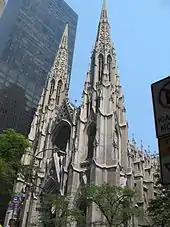



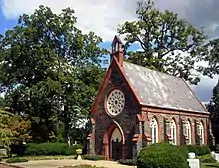


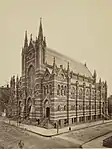
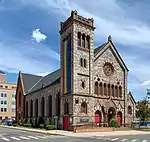
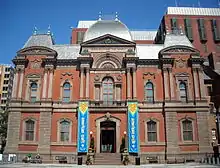
_crop.jpg.webp)

